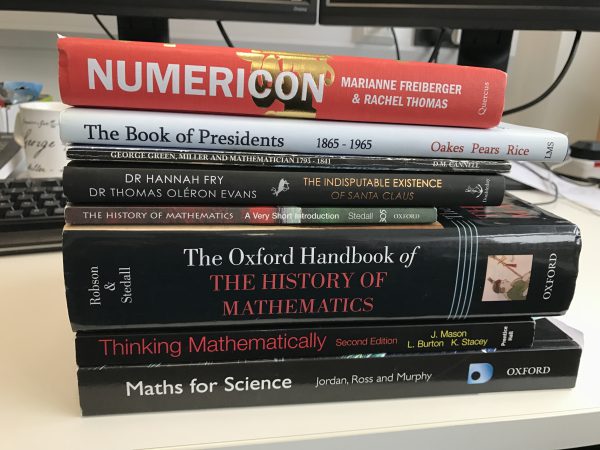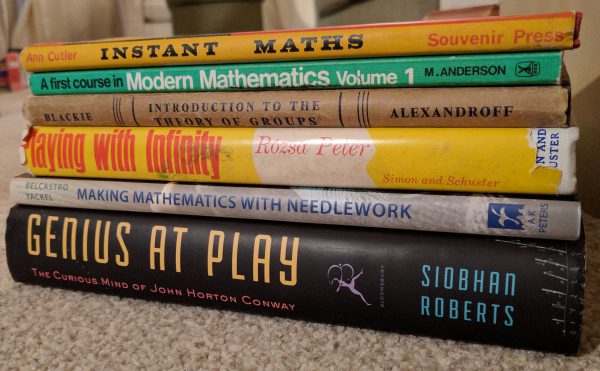Today is International Women’s Day, so we’ve taken a moment to think about the woman mathematicians in our lives.
We each have fairly sizeable collections of maths books, which prompted CLP to wonder how many of them are by female authors. A quick scan of our respective bookshelves later, here’s what we found.
Katie
I’ve found four books I know for sure are by female authors – several others just have a surname or initial/surname. I’m also convinced I used to have a copy of Hannah Fry’s TED book The Mathematics of Love, which I owned from when I reviewed it for this site, but I must have passed it on to someone else.
Of these five books, precisely one was bought by me as a book I’d like to read – Timandra Harkness’s witty and light-hearted analysis of Big Data – Does Size Matter, and the rest I all own for technical reasons. Maths in 30 Seconds by Anne Rooney is a book on which I consulted on technical aspects of, and they sent me a copy; I bought Masha Gessen’s excellent Perfect Rigor, which is a biography of Grigori Perelman and the story of his proof of the Poincaré Conjecture, in order to read up on the topic for a talk I was writing, and Daina Taimina’s Crocheting Adventures with Hyperbolic Planes was (genuinely) a wedding present Paul and I received.
I have a total of 59 maths books on my shelf which are a mixture of books I’ve bought for myself, books I’ve bought for work purposes, books I’ve been sent to review for this site and books I’ve inherited from others who review books for a living. This means my females make up around just under 7% (8% if I can find my Hannah Fry book) of my collection. For the record, I have 5 Martin Gardner books, and am duly ashamed of myself. I can only conclude I really need to step up my game and spend less of my reading budget on classic sci-fi, and look up some more diverse maths authors.
Peter
When I taught maths to forensic science a few years ago, the recommended book was one of the classic maths for engineers textbooks. Forensic science students study bits of chemistry, biology, physics and some computing, maths and stats. I felt quite awkward recommending a book targeted to engineers, but found Maths for Science by Sally Jordan, Shelagh Ross and Pat Murphy to be written at the right level and targeted to the right audience – explaining things simply and clearly using examples that would appeal to scientists.
Thinking Mathematically is a classic by John Mason. The revised second edition is by John Mason, Leone Burton and Kaye Stacey, and I was introduced to it by Noel-Ann Bradshaw, who wrote this review. I used some of its ideas and problems with our first years this year in a problem-solving session.
I recommend The Oxford Handbook of the History of Mathematics by Eleanor Robson and Jackie Stedall in my history of maths module, along with Jackie Stedall’s The History of Mathematics: A Very Short Introduction. The handbook, a collection, provides a look at the history of maths with special focus on the contribution of different cultures. The Very Short Introduction, I tell my students, has a clear advantage – it is Very Short. At a little over 100 pages, it gives a good clear overview of some issues to consider when studying history of mathematics, and presents a little history along the way. Students tend not to read recommended books, but I implore them to at least read the barely-three-page introduction (available on Google Books), saying if they do then it would enhance their understanding of the study of history of maths considerably.
The photo also shows the most recent book I read, The Indisputable Existence of Santa Claus by Hannah Fry and Thomas Oléron Evans, which I was delighted to receive and read over the Christmas break. It is silly and fun, with some series maths at its core.
Also pictured are George Green, Miller and Mathematician, one (not the best) of a series of increasingly-detailed books about Nottingham’s famous mathematician by D. Mary Cannell; the LMS’s The Book of Presidents by Susan Oakes, Alan Pears, and Adrian Rice; and Numericon by Marianne Freiberger and Rachel Thomas of Plus Magazine.
I also have a bunch of older books that go “initial. surname” which I haven’t assumed to be female in my response.
I do have more maths books by female authors than by Martin Gardner, though this may be due to paucity of Martin in my collection rather than a great number of female-authored books. These 8 books sit in a cupboard of 112 mathsy books, meaning they represent a mere 7% of my collection.
CLP
I have between four and six books definitely by female authors, out of 83. I can’t decide whether to count the excellent Genius at Play by Siobhan Roberts, because it’s a biography by a non-mathematician, or An Introduction to the Theory of Groups because it’s a translation by Hazel Perfect of an original Russian text by Paul Alexandroff.
The others are a mixed bag: Making Mathematics with Needlework by sarah-marie belcastro and Carolyn Yackel is the classic crafty maths book; Playing with Infinity is a very good pop maths book of the whirlwind-tour-of-the-undergrad-syllabus sort by Rózsa Péter (if you’re going to read a pop maths book, they’re all pretty much the same so you might as well make it this one); A first course in Modern Mathematics by Marie Anderson is an unremarkable textbook; and Instant Maths by Ann Cutler is all about the Trachtenberg system for mental maths, about which the less said the better.
I own four books by Martin Gardner, so I just reach Martin-to-Mrs parity.
Most-read maths books on Goodreads
$n=3$ is not a big sample, so let’s take a look at the most-read maths books on Goodreads this week. Not all of the books are really about maths – there are some pop science and computer science books in there – and we’ll exclude the children’s books as well. That leaves just over 40 maths books, give or take a couple, of which four are written by women:
- Weapons of Math Destruction by Cathy O’Neill comes highly recommended – pity it hasn’t made more of a splash over here!
- A Mind for Numbers by Barbara Oakley seems to be the companion book for a big Coursera MOOC.
- Mathematical Mindsets by Jo Boaler is the hot education craze of the moment. If you’re a teacher, you’ve probably heard of Jo Boaler, and even if you’re not, you might have heard some of the fairly heated arguments for and against the ideas in this book.
- How to Bake Pi by the ubiquitous Eugenia Cheng rounds off our list. By all accounts it’s a good read!
The Goodreads list has a heavy US slant, but the proportion of books by female authors is still just under 10%.
So, do you own more books by Martin Gardner than by female authors? Have you broken the 10% female authors barrier? What book by a female author should no mathematician be without?



You made me look… I currently have 10 Gardner books around (far more than I have female math authors), BUT only 3 of those are math-related (the rest are essays & his autobiography). …and those 10 Gardner books represent more than I have from ANY other author, on ANY topic (though sometime in the distant past I had a dozen+ Gary Larson “Far Side” volumes! ;)
In fairness, we really need to know what proportion of widely-distributed math books the last few decades were even authored by females; I suspect it’s quite low (though now growing).
Interesting too, over half the books you highlight in your photos I’ve never heard of! Not sure if that’s because of my different interests or those volumes just never had much presence in the U.S.?
My score:
Gareth A. Jones and J. Mary Jones, Elementary Number Theory
Aviva Petrie and Caroline Sabin, Medical Statistics at a Glance
Linda Keen and Nikola Lakic, Hyperbolic Geometry from a Local Viewpoint
Serafina Cuomo, Ancient Mathematics
Leila Schneps and Coralie Colmez, Math on Trial
That’s five (or four and a half) against five Martins (if you count the Annotated Alice). Out of … I don’t know how many exactly, but it’s not two digits.
I checked a few of the Initial. Surname authors, just in case. All men.
Very few books written by a woman solo. Off the top of my head, I have Margaret M. Gow’s A Course in Pure Mathematics, and Introduction to Complex Analysis by Hilary Priestley. And Lilian R. Lieber’s Modern Mathematics for T.C.Mits.
Then there is Abramowitz and Stegun, and Boyer and Merzbach’s History of Mathematics. I also have Dorothée Aeppli’s translation of Polya and Szego, and Smith & Latham’s translation of Descartes Geometry. Unless there are a number of female mathematicians hiding behind initials, that may be it.
So out of 7 books, 2 are translations (one of them in collaboration), two are editors of a second edition, and only 3 actually wrote a book solo.
Having scoured through my complete collection, I also note that I have D.J.O’Connor and Betty Powell’s Elementary Logic — another collaboration.
I have a colossal, though idiosyncratic, collection (it’s what I do), and I am equally surprised at the fewness of the female authors of mathematics texts.
And not only do I have more Martin Gardner books than books by women, I also have more Ian Stewart and Rudy Rucker books than books by women as well.
What does it mean if you have no books by Martin Gardner?
(I have three maths books with women authors: Big Data, Learning to use Statistical Tests in Psychology, and Probabilistic Graphical Models).
Ivan
I think it means you have room for a Martin Gardner book in your life!
I have Antonella Cupillari “The Nuts and Bolts of Proofs”, translated to Russian. And I also “borrowed” an electronic copy of Susanna Epp “Discrete Mathematics with Applications”, it’s too expensive, I can’t afford to buy it.
I think quality matters more than quantity. Those are brilliant textbooks, IMO.
I have thousands of math books, so of course I do own more by women than by MG. The most by one particular woman is either those by Lillian Lieber, author of Take a Number and others, or those by Constance Reid, Julia Robinson’s sister.
Heard about Gardner on Science Friday, NPR ~ Always, distraught BC I just didn’t GET Algebra; forever wanting to GET it!